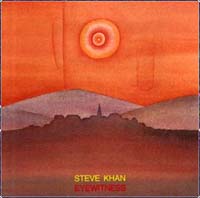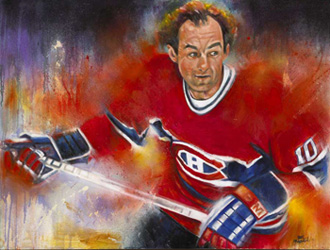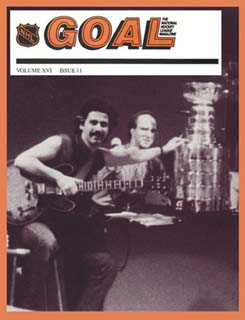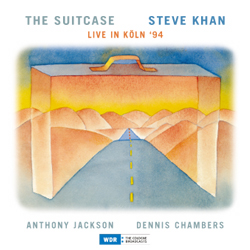Steve Khan's "Guy Lafleur"
Lead sheet
Over the years, people have asked me how and why there has been such an influence of Latin music in my writing and playing, and to this I really have no one good answer. But perhaps, a tune like "Guy Lafleur" is as good an example as to why people have come to view the music of Eyewitness as something from the "Beyond Latin Jazz" zone.
When I was beginning to formulate this tune, I knew that I had the bass line, performed to perfection and then some by Anthony Jackson; and the looping chordal feel which you see at [I2]. However, I can't honestly say that I recall telling Steve Jordan that the feel and attitude should come from his cowbell. And when you combine that with the presence of Manolo Badrena and his chekeré, you somehow begin to have something connected to Latin music.
 The wonderful thing, at least sometimes, about not really knowing so much about a musical genre is that you are just flying by instinct, your best musical instincts. And from there, one can come up with something new and different, but quite by accident. It didn't take long too learn that the fundmental rhythms of Latin music are comprised of various patterns which are connected to the all-important clave. Though I have chosen to write "Guy Lafleur" in 3/4, I am certain that true Latin players would view this as being in 6/8. And so, with this, there are very specific bell patterns which one must play. For example, you can hear Marc Quiñones execute this traditional bell pattern to perfection on the tune, "Clafouti" which was recorded on "YOU ARE HERE," and appears at Korner 1.
The wonderful thing, at least sometimes, about not really knowing so much about a musical genre is that you are just flying by instinct, your best musical instincts. And from there, one can come up with something new and different, but quite by accident. It didn't take long too learn that the fundmental rhythms of Latin music are comprised of various patterns which are connected to the all-important clave. Though I have chosen to write "Guy Lafleur" in 3/4, I am certain that true Latin players would view this as being in 6/8. And so, with this, there are very specific bell patterns which one must play. For example, you can hear Marc Quiñones execute this traditional bell pattern to perfection on the tune, "Clafouti" which was recorded on "YOU ARE HERE," and appears at Korner 1.
As it was with "Where's Mumphrey?", Steve Jordan's unique bell pattern has become firmly associated with this tune. But, it is part of a 'whole' rhythmic portrait which, to these ears, gives us big loops of rhythm in 3. Written in this way, you can see that the bass drum appear in bars 1, 3, 5, and 7 of the 8-bar pattern. The snare drum, with Steve's huge sound, appears in alternating even numbered bars. Steve also adds an interesting 'kick' in bar 7 by playing the bass drum on the and-of-one which sets-up the turnaround for the figure in bar 8. When I have performed this tune with 'real' Latin musicians, it is virtually impossible for them to view Steve's inventive pattern as an opportunity to learn to do something different. It is not because they are stubborn, it is only that, practically from birth, they are so rooted in the bell patterns of their music, they cannot break away from them. It is really fascinating how deep these connections run. So, I have written out the drum part, or the essence of it in [I] so you can see exactly what he was playing.
Like many of the tunes from this period, "Guy Lafleur" seems to have 3 fundamental sections, though I think that [A] and [B] could be considered as part of the same section. They just occupy different harmonic zones with the ever-present rhythm continuing. Those harmonic areas being Dbm7(sus) and Em7(sus)/A. Because of the spellings of the chords, they might appear to be a bit disconnected, but the movement of going up a minor 3rd is very common even though the bass travels down a major 3rd.
 More than this, the top note of the Dbm7 chord is a Cb which, when enharmonically spelled becomes B-natural which is the top note of the Em7(sus)/A chord which follows. It makes for a seamless transition.
More than this, the top note of the Dbm7 chord is a Cb which, when enharmonically spelled becomes B-natural which is the top note of the Em7(sus)/A chord which follows. It makes for a seamless transition.
Letter [C] is simply a release to build to a point where the hypnotic nature of the rhythm, and the floating harmony can be broken for an instant. During the 'live' performances we now extend the fermata in bars 15-16 of [C], and it then becomes the responsibility of the drummer to again begin to play the basic rhythmic pattern. When it feels right, the bass and guitar return together, and the piece moves forward.
Letter [D], which is the guitar solo section, succeeds or fails based upon the group usage of space, dynamics, and intercommunication. All we have agreed upon is that our tonal center is Dbm7, nothing more, but anything can happen. As the piece has developed over the years, I try to construct something which rises to the eventual playing of the chordal passages at [D2] and we then move ahead to [E] which makes the chord change to Em7(sus)/A. On the record, we come down in volume for [E2] which was intended to be a bass & drum 'dialogue.' However, if for some reason, the bassist is not comfortable playing in this section, the guitar solo would simply continue, and eventually we would cue [C2].
Again, in 'live' performance, as the drums are supposed to bring us back into rhythm, what is indicated as [I] on Pg. 4, could become a full-blown drum solo. As that would build, eventually Anthony and I would return with [I2] and the reprise of our main melody at [A3]. One last time we play [I2] and then there is a deep drop in volume as [F] begins. As you will notice, my figure completely changes and reveals accents that might indicate a sense of 2 over 3. Of course, in a 4-bar figure it all works out.
As I have stated on countless occasions here at the site and in various interviews, when "EYEWITNESS" was recorded in November of '81, we really didn't know what we were doing. This is easily noted by the fact that NONE of the 5 tunes had formal endings! So, there are aspects to this lead sheet which now add in what has developed over time. At [F], Anthony now usually plays long notes, 2 bars each, of Db, and then 'A.' Which gives the piece, for the first time, a sense of going back and forth between Dbm7(sus)[which could easily now be spelled as C#m7] and Amaj7. In [F2] I have transcribed a sample 8 bars by Anthony which demonstrates how free he is to move the harmony around at will. The rise in intensity is totally dictated by the interaction between the bass and drums, my ostinato figure remains the only constant here. Then one of the great, great moments of Eyewitness 'magic' appears at [F3], as on a cue between them, Anthony and Steve break into a rhythm which feels as though they are suddenly playing in cut-time 4/4 over the 3/4 rhythm of the guitar figure. And when they hit it, they hit with total slam-bam-ocity, holding nothing back!!! For this time, it certainly had all the 'rock & roll' energy of the Police. In [F3], you can also view my humble transcription of what Anthony, in part, played on the recording. It will give the bassists amongst us a foothold on trying to comprehend the incredible musical mind of Anthony Jackson!!! At [F], Anthony now usually plays long notes, 2 bars each, of Db, and then 'A.' Which gives the piece, for the first time, a sense of going back and forth between Dbm7(sus)[which could easily now be spelled as C#m7] and Amaj7. In [F2] I have transcribed a sample 8 bars by Anthony which demonstrates how free he is to move the harmony around at will. The rise in intensity is totally dictated by the interaction between the bass and drums, my ostinato figure remains the only constant here. Then one of the great, great moments of Eyewitness 'magic' appears at [F3], as on a cue between them, Anthony and Steve break into a rhythm which feels as though they are suddenly playing in cut-time 4/4 over the 3/4 rhythm of the guitar figure. And when they hit it, they hit with total slam-bam-ocity, holding nothing back!!! For this time, it certainly had all the 'rock & roll' energy of the Police. In [F3], you can also view my humble transcription of what Anthony, in part, played on the recording. It will give the bassists amongst us a foothold on trying to comprehend the incredible musical mind of Anthony Jackson!!!
For an ending, after playing this section for quite some time, when the moment feels right, a cue is given and the the ending is played by accenting the beats shown in bars 3-4 of my figure at [F]. Nothing particularly fancy, nor clever, but very functional. If there's a question, an 'A' must always be the last bass note!
Over the many years that have passed since 1981, I have been asked about the sound that I used on this tune and the "EYEWITNESS" album in general. The fundamental guiding principle for me, after the Columbia years(1977-1979) was to go back to a more pure and simple guitar sound. In essence, that was to be a Gibson ES-335 guitar played direct into an amp, and with a little reverb for treatment. As the music for this particular album developed, it just seemed that certain sections needed a little something extra, and so, on this album, that sound was produced with the help of the BOSS Flanger(BF-2). It was a rather primitive sounding effect in mono, but people seemed to respond to it. If you read below about the performance of "Guy Lafleur" on the "THE SUITCASE" from 1994, the major sonic difference is that then I had graduated to what became my true sonic voice, where effects are concerned, the Ibanez Digital Chorus/Flanger(DCF-10) which I have written about extensively at the EQUIPMENT page here.
The tune was named for the great Montreal Canadiens right-winger, Guy Lafleur. His skating, finesse, and wicked shot represented everything that was beautiful about ice hockey, as played in our NHL. Something about the big rolling loops of the 3/4 rhythm made me think about skating(which, by the way, I can't do), and Guy's incredible sense of style, grace and dignity.
As I have just returned from touring Europe [That was back in 2005!], and having performed "Guy Lafleur" often with Joel Rosenblatt and Charles Flores, it served as testament that, if a tune, such as this, is performed with sound musical execution, even after some 25 years, it will still function well. Just as if it had been composed far more recently. In other words, if the music is played with a degree of precision, and all the proper dynamics are exercised, everything will go well. Always keep these things in mind when playing your own music.
Addendum: With the release in 2008 of "THE SUITCASE" a double live CD with Anthony Jackson and Dennis Chambers recorded in Köln, Germany on May 17th, 1994, originally for a WDR radio broadcast, I believe that it becomes necessary to revisit the analysis pages related to the 9 original tunes which appear. Yes, for the tunes which appeared on the original "EYEWITNESS" recording from 1981, some 13 years had passed, but the performances you now hear represent the growth of the music through live playing and improvising. In most cases, what you now hear on this CD will be much closer to the lead sheets you've been viewing since the launching of the website in September of 1998. Yes, for the tunes which appeared on the original "EYEWITNESS" recording from 1981, some 13 years had passed, but the performances you now hear represent the growth of the music through live playing and improvising. In most cases, what you now hear on this CD will be much closer to the lead sheets you've been viewing since the launching of the website in September of 1998.
Like "Where's Mumphrey?" - "Guy Lafleur" has also been a piece which, for me, is the perfect way to begin a set of our music. Again, it is rich with mood and attitude and it becomes easy to fall into those places. The Intro, which now features, Anthony and Dennis alone is also perfect because it provides a wonderful respite from having to hear my guitar for the whole evening. In that sense, breaking down the forces, is always the best thing to do. And in this case, it is essential when there is only a trio. As this particular solo section builds, I used one of my rare effects, the upper octave harmonizer effect from the rather simple Boss Pitch Shifter, the PS-2.
On a side note, this performance is also flawed, and the error was totally mine. The problem is that I never went to play [C2] after the conclusion of the solo. This appears on Pg. 3 of the lead sheets. It a huge error and, no doubt, threw Anthony and Dennis for quite a loop. In truth, it is a credit to their ears and their spirit of "we'll find our way out of this mess - together!!!" that we did work our way back to Dbm7, though ever so briefly, before hitting [F] and riding out until the final cue!!! My error could have been a total train wreck. But, this is the beauty of playing like this. You have to trust one another and make your way back from a false step.
[Guy Lafleur Portrait by: Gary McLaughlin
Photo of Steve with the Stanley Cup, alongside Paul Shaffer, at the "LATE SHOW" w/ David Letterman, New York City. Taken when New York Islander, Denis Potvin brought the Cup over after one of the Isles four consecutive wins, '80-'83! The photo appeared in an Ira Gitler article for GOAL Magazine. Now THIS was a thrill!!!]
|

